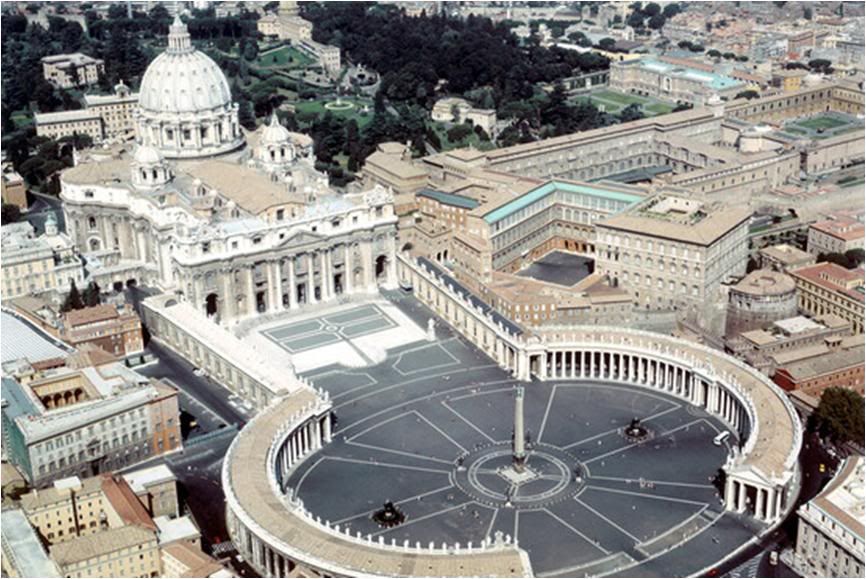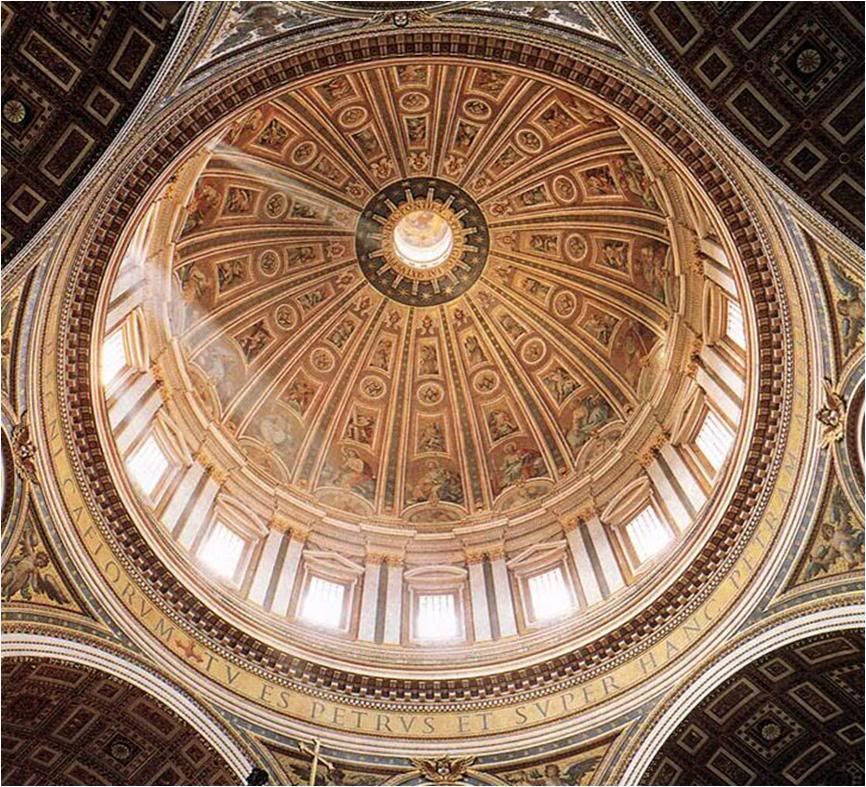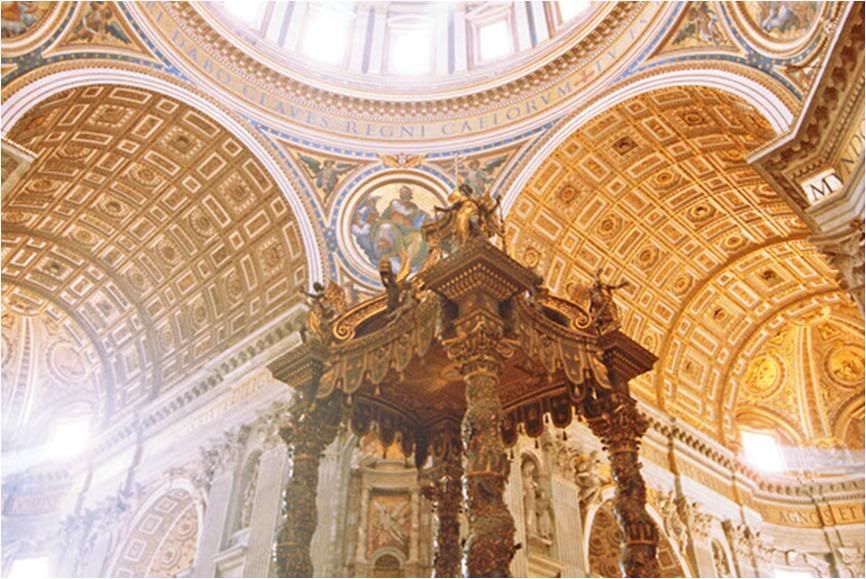 Here's a beautifully written brief history of how St. Peter's came to be built, which also brings up some information one may not have known before.
The Splendor and the Scandal
The story of St. Peter's Basilica,
Here's a beautifully written brief history of how St. Peter's came to be built, which also brings up some information one may not have known before.
The Splendor and the Scandal
The story of St. Peter's Basilica,
a miracle in stone that took
more than a century to complete
By R. A. SCOTTI

August 24, 2009
The first time I saw St. Peter's, I was 19, new to Rome and starting to panic. I was late for a papal audience. Rushing in the general direction of the Vatican, I arrived breathless and confused at the outer rim of Bernini's colonnade. I didn't realize where I was, until I burst through the Doric columns into the sublime surprise of St. Peter's Square.
In 1505 when the formidable Pope Julius II began planning a new basilica to St. Peter, he imagined a miracle in stone that would dwarf the epic constructions of the Caesars and proclaim the power and the glory of Christ and his Church.

How that dream was realized over a tumultuous century, at an incalculable cost, is a saga as convoluted and controversial as the Church of Rome.
Conceived on a colossal scale, created from a confusion of ideas and consuming the genius of the greatest artists of the age, St. Peter's became both the splendor of the High Renaissance and a scandal of epic proportions.
Rome already had a basilica of St. Peter, erected 12 centuries earlier by the Emperor Constantine. It was a sacred site where every Holy Roman Emperor since Charlemagne had been crowned.
When Pope Julius decided to replace the old church, he provoked such fury that his architect, Donato Bramante, was forced to adopt a novel approach. Instead of leveling the original basilica and laying a new foundation, he proceeded in sections, demolishing and then constructing piece by piece.
Bramante, a middle-aged architect with no singular accomplishment, seemed an uninspired choice. (His Tempietto, or "Little Temple," the Renaissance architectural ideal in microcosm, was still under construction.) But Bramante's ambition was as extravagant as the Pope's.
He envisioned a large Greek cross, its four equal arms surmounted by an immense saucer dome that rested on four discrete piers. It was a risky experiment. The dome was 142 feet in diameter, equal to the Pantheon, and at 300 feet more than twice as high. No one had ever vaulted such a broad expanse at such a dizzying height and balanced it on such dubious supports.
Bramante was so eager to raise his huge dome that he employed an unorthodox strategy. He built the basilica from the center out. By completing the crossing and the four giant piers, and joining them with coffered barrel vaults, he ensured that the heroic scale could not be diminished.
When Bramante died in 1514, other architects began to question his plan. Although many artists, beginning with Raphael, tried their hand at building St. Peter's, no one dared to raise the dome.
Years passed. Architects and plans changed, building costs escalated. To pay for them, succeeding popes peddled indulgences. Absolution was bartered for building funds, infuriating Martin Luther and other Reformation figures, and culminating in the division of the Christian West into Protestants and Catholics. The Basilica project was abandoned.
Sketches from the period show the husk of St. Peter's like a failed dream — an apt symbol, some thought, for a Church that had lost its way, forgotten its purpose and forsaken its mission.
Resuming work on the basilica became a priority of the first Counter-Reformation Pope. Paul III saw a glorious new St. Peter's as a metaphor for a reborn Church of Rome, and he turned to Michelangelo Buonarroti to realize it.
At first, Michelangelo refused. The whims of Popes infuriated him. Paul flattered, cajoled and ultimately commanded obedience.
Michelangelo was 70 when he assumed the grand enterprise "against my will." Although ambitious young architects complained that he was impossible to work with — he was too old and his faculties were failing — for almost two decades, through five pontiffs, Michelangelo worked with undiminished fervor.
He completed the drum, erected most of the attic and designed a new dome. When he died in 1564, in his 89th year, he left a 15-foot scale model so that the dome of St. Peter's would be completed to his exact specifications.
Many architects followed Michelangelo, just as many had followed Bramante. More than 20 years passed. No one was able to build the dome or dared to suggest an alternative. The basilica drum towered over the city like a headless giant until 1585, when Sixtus V, another stubborn old man, was elected Pope.
Sixtus commissioned Giacomo della Porta to complete the dome, and he allowed the architect 30 months to do the job.
Della Porta, who had been Michelangelo's pupil, did the unthinkable. He redrew the master's design, creating a far bolder silhouette, and he raised the new dome in just 22 months.
Dwarfing every other construction, the dome of St. Peter's soars 452 feet and spans a 138-foot diameter. It is three times the height of the Pantheon dome and 100 feet higher than the Duomo in Florence.

The inner shell visible inside the basilica retained Michelangelo's rounded contour. The outer shell that fills the sky over Rome is a higher, more dramatic ellipse.
Della Porta died in 1602, having brought the new St. Peter's to the point of completion. All that remained was to add the façade. Instead, a new pope, the Borghese Paul V, and his architect, Carlo Maderno, returned to the drawing board.
They extended one arm of the Bramante-Michelangelo-della Porta design, changing it from a Greek to a Roman cross that would accommodate larger crowds. The flamboyant baroque genius Gianlorenzo Bernini would give the basilica a grand entry, enclosing a space the size of the Colosseum with his magnificent piazza and colonnades. But that would come later.
With the structure finally finished, on Nov. 18, 1626, 1,300 years to the day after the dedication of Constantine's basilica, the new St. Peter's was consecrated.
It had been 120 years since Julius II broke ground. Over the decades of construction, Magellan's fleet had sailed around the world; Henry VIII had taken six wives and disposed of four of them; Shakespeare had made the world his stage; the Mayflower had landed at Plymouth Rock; and an extraordinary feat of architecture and engineering had emerged.
Two million tons of stone were transformed into spirit, creating what Rome's pre-eminent historian, Edward Gibbon, called "The most glorious structure that ever has been applied to the use of religion."
 Today, the visitor entering St. Peter's experiences unity as immutable as dogma with no hint of the conflicts and perils overcome. Human follies seem too petty to have ever played a part here. The heart stops. The soul soars. The power of the idea is transcendent.
Ms. Scotti is the author of Vanished Smile: The Mysterious Theft of Mona Lisa (Knopf 2009).
Today, the visitor entering St. Peter's experiences unity as immutable as dogma with no hint of the conflicts and perils overcome. Human follies seem too petty to have ever played a part here. The heart stops. The soul soars. The power of the idea is transcendent.
Ms. Scotti is the author of Vanished Smile: The Mysterious Theft of Mona Lisa (Knopf 2009).